|
Journey So far:
Rashmi Tapadia is passionate about art and beauty that always
driven her to know the techniques and feelings behind each creation she
sees. Her education in Computer Engineering did not stop her to live a dream
of becoming a designer by embarking on a own expedition. Her marriage with
Dr. Prashant in 2003, who inherited legacy of art and collectibles of seven
generations from his family that once served Princely States of Deccan as
jewelers, changed her perspective of art. It was perfect union of legacy of
art and art lover. Since then, Rashmi incorporated Maratha art in
their conquest and specialized her research into Maratha (rather known as
Deccani) art & history. She has traveled extensively to North America and
Europe. Visits to invaluable collection of art and monuments underlined with
the public interest, awareness and the glory each piece of art achieved made
a deep impression on her. It also highlighted the distinction between the
Indian approach towards the art. It was the negative feeling that so called
developing nation is witnessing; demolished monuments, faking of the art and
making profits using emotional keywords like tradition and culture without
truly connecting to the history. Her return to India was eminent as it felt
very deep in heart that she should share her experience and contribute
something to connect people to the magnificent facets of Indian art. Her
training in miniature paintings, watercolor, tapestry weaving, and ability
to understand the art gave her strong foundation to march on to this path.
In 2006, she returned from United States with higher studies, her first
visit to Yeola and Paithan shadowed with news that many Paithani
looms were for sale due to challenges posed by machine-made ones. Local
dealers who built empires from weavers sweat turned them down when they saw
significant profits in machine made paithanies and fancy modern fabric.
Some of weavers who were associated for many generations were distressed and
opted for alternative work such as construction/farm labor or helper, which
gave them more security than weaving. At that haste moment, Touch of
Class has conceived. The first task was to bring back those who left and
then save the rest. Challenge was to create an environment and opportunities
to bring people once again choose Paithani and bring fair returns to
weavers. Parallel and most difficult task was to create a support system for
entire family of artisans such that in difficult times, they will remain
faithful to this art of weaving. Today, Rashmi leads strong force of 75
artisans those are weaving future of most celebrated Indian art. It is her
pride that with no external aid or funding, she has created a model of
self-sustained system and dignity to each family.
Her venture is paying grandly with a range of clients she
relies for support. Starting from top Indian corporate houses to art lovers
around the world are joining her quest of revival. Serving over fourteen
hundred strong clientele, Rashmi so far sold Paithani Sarees and
Furnishings to over 40 countries cutting across origin and religion.
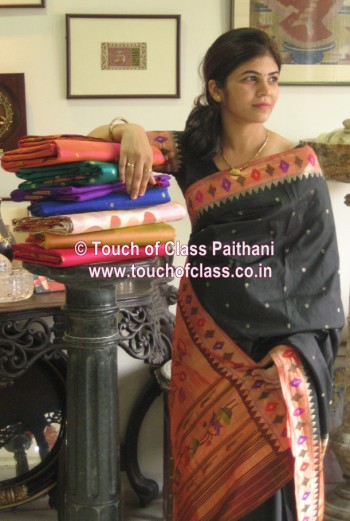
Rashmi Tapadia in her favorite Black Paithani (Copyright 2010-2012 TOC)
Expertise and
Knowledge:
Rashmi studied every aspect of Paithani weaving, Maratha
art and history, carrying a unique blend of knowledge of the past and
present that forms a strong foundation for its revival and glorious future.
Being part of every stage of process, from buying fine silk and precious
metal to make Jari to the finished Paithani she not only monitors
finest quality but it also allows her to experiment new ideas and
innovations in designs. Her perspective and knowledge of various forms of
art allows her to blend unique designs those are being highly appreciated by
her clientele. Her role in upbringing quality of artisan’s life has earned
assurance of revival at slower but sustainable pace. Rashmi also collected
and sold many antique Paithani Sarees to art collectors around the
world. She is currently writing a monograph “Paithani: Celebrated Indian
Art” that portrays culture and tradition of this great Indian art.
Revival:
Revival in its literal meaning the efforts towards the art to be
alive and practiced which in turn depends on the market force. Changing
social concepts and generations demand different objects that are suitable
for present times. Paithani remained synonym of a Saree for all along and
thus lost track changing times. It retained its status of traditional
wedding or celebration saree and lost the necessity of attire one may count
for best appearance no matter what occasion is. Rashmi’s extensive research
and travel around the world made her understand various outlooks of
different generations and geographic locations those having their own
expectations. New textiles ranging from cushion covers, stoles, curtains,
tee-shirts, wall hangings, burkha’s and dress tops to laptop bags are being
designed and weaved at her looms. This range of products in which the
traditional art of Paithani weaving is being preserved while incorporating
modern look and utility. Rashmi strongly believes that getting new
generation and more variety into any traditional art is only way for its
survival. Her endeavor has wholeheartedly welcomed by many corporate
enterprises, hotels and private clientele and leading designer houses across
India, North America and Europe.
Legacy of Paithani:
Paithani, popular by its name and unique art and
tradition is carrier of legacy dating over 2000 years. Born in Paithan, the
splendid capital of Satvahana Dynasty in 200 BC by the banks of divine
Godavari
River, under the patronage of Satvahana’s and later progressed throughout
Deccan region. The ancient technique of tapestry has been practiced to make
Paithanis, where multiple weft and warp threads of different
colours
along with gold and silver threads weaved together forming a fascinating
piece of silk. At times, Romans imported this Golden Woven Fabric in
exchange of gold of equal weight. Survived under changing rulers, art of
Paithani flourished under Aurangzeb, who not only brought life to it but
also incorporated many novelties in appearance. Floral motifs & AmarVell
were contributions from Mughal era. Nizam of Hyderabad was most famous
admirer of Paithanis. After declining Mughal influence, Peshwa of
Pune once again took it under wings by settling weavers to Yeola, a small
town near Shirdi, where Paithani took new dimensions in both design
and popularity. Asawali, a motif of flowering vine has credited to Peshwa.
Afterwards, Paithani remained ignored textile of Maharashtra in
absence of real patronage until Government of India and Maharashtra state
along with private enterprises took special interest in its revival. Once
again, Paithani is becoming an iconic art of the India dissolving
borders of geography and religion.
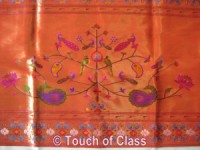
Paithani carrying cultural legacy of Maharashtra have
special meaning in life of women who forms pillar of every family and
society. It is the only textile, which unite entire elements of life in the
form of blessings and protection to the wearer. Made from natural silk or
cotton with precious metal of gold and silver, it gives the Midas touch.
Particularly, the motifs that set Paithani above all other
traditional fabric bear special significance of true Indian philosophy of
living in harmony with nature and its elements.
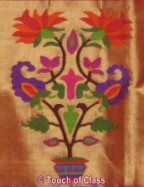
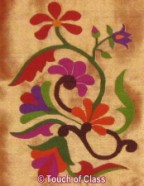
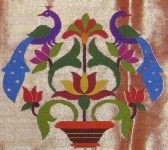
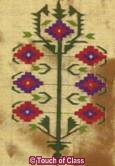
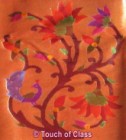
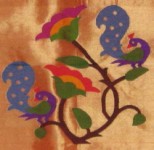
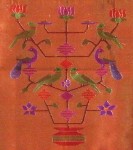
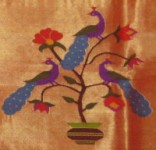
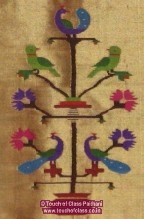
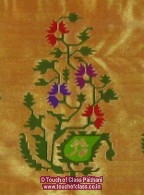
Traditional motifs those are still popular since its birth over
2000 years ago. Bangle-Peacock motif (Bangadi-Mor), where bangle represent
completeness of woman being sign of Saubhagya, Peacock, bird of paradise
indicate beauty, royalty, wisdom, wholeness, dignity, love and believed to
be a guardian. Peacock also carries sense of energy that comes from its
renewal of feathers every year. Its association with Goddess Sarswati
represents benevolence, patience, kindness, compassion, and luck. In
Muniya or Tota-Maina motif parrot is symbolized. Parrot is sign of love and
passion. Red beak represents the red earth before the rain or unfulfilled
desire and the green feathers represent the green earth after the rains or
fulfilled desire, full of joy. Lotus or Kamal Pushpa is motif of close
resemblance with Ajanta Caves located in Aurangabad, Maharashtra. It is the
sign of rebirth, it closes in the evening and falls to the water, but in the
morning, it opens lifting above the surface. It also represents essence of
life apart from royalty, beauty and purity. Coconut border (Narali) was most
common Paithani border until the end of 19th century. Coconut
also known as Sriphal is fruit of gods. It symbolies complete usefulness,
selfless service, prosperity and generosity. Coconut tree or Kalpvirshka is
termed in Hindu mythology the tree that grants all wishes. Adding sense of
beauty and aesthetics more motifs such as Asavali, Akruti or geometrical
figures, Amarvell and flowering wine were incorporated with passage of time.
Each Paithani is a dedicated and painstaking work of an
artisan who incorporates his soul and heart in weaving every thread that
binds all elements of life in the ‘one’ without which it is just another
fabric. Passing love and care from mother to daughter for generations,
Paithani achieved its place of most precious heirloom of every woman.
Role of Touch of
Class:
Although, many private, semi government and government
institutions are working towards the survival of this magnificent art of the
India by means of tax waivers, loans, funds, retail outlets, low cost looms,
training and direct selling, all such efforts are concentrated with
handpicked weavers and groups. The essence of survival remained to market
force that is fading. Spread of power looms posed serious competition to
this hand woven art by offering low cost and large variety. Unable to
recognize the difference, both retailers and buyers are going for cheap
machine-made variants by parting to their role in up keeping tradition and
culture that handed to us by dedicated work of over two thousand years.
Culture and tradition are not just keywords for modern literary
but are essence of human life that weaves past with future. One cannot count
on future if the present is disconnected. Today some weavers are doing their
best to keep this art alive but are reluctant to bring future generations in
it. Low returns, dependability to handful appreciative buyers, competition
within and with machines, poor development of area and surroundings is
taking its toll. Very few weavers are keeping children around who can
watch-participate and take this art to next generation. Uplifting of entire
weaver family is not accounted and not cared for.
Touch of class, working deeply into changing life of weavers.
Its principal aim is to support and brighten life of entire family and
dependents of artisans starting from education of children, training and
most importantly assure high returns for their creativity. Touch of class is
probably only enterprise that passes 90% of sell price to weaver while most
others do opposite. It offers competitive high returns, which brings
Paithani weavers at par to other professionals and assures them
stability and secured future that lacked for many decades in their struggle
to survive.
Touch of class is instrumental in preserving ethnicity, purity
and highest quality of each Paithani while making life of artisans
dignified and sustainable in challenges of present and future. It
wholeheartedly requests your continuing support and appreciation for this
magnificent Indian art, which has delicately woven our culture and tradition
with love, care and richness for over two thousand years.
WARNING:
Contents and information on this page is protected by copyright of Rashmi
Prashant Tapadia, No part or full text, logos and images be used in any form
without prior permission of copyright holders, failing which will be
prosecuted under the law of land. Copyright 2010-2014
|